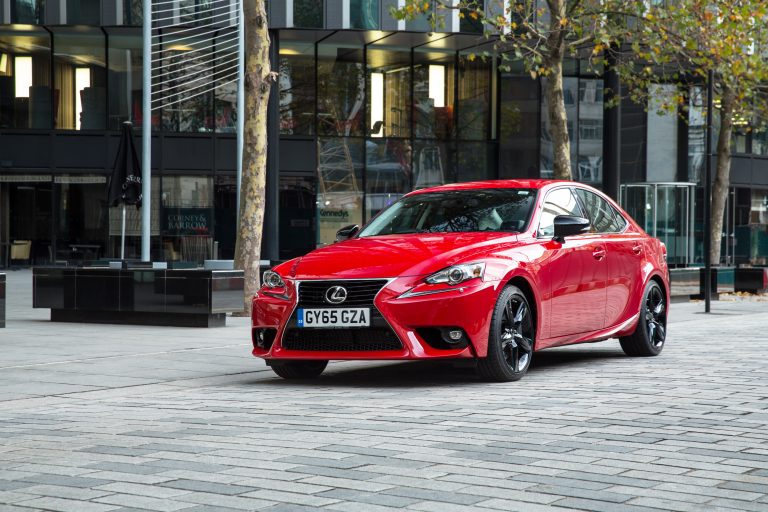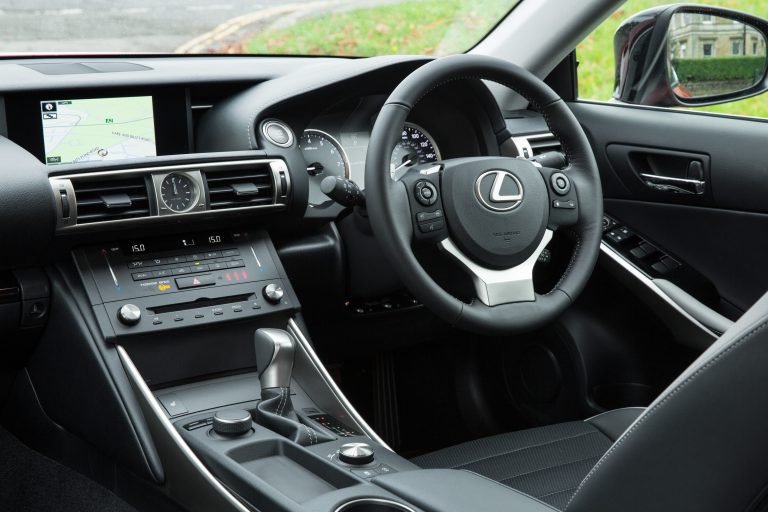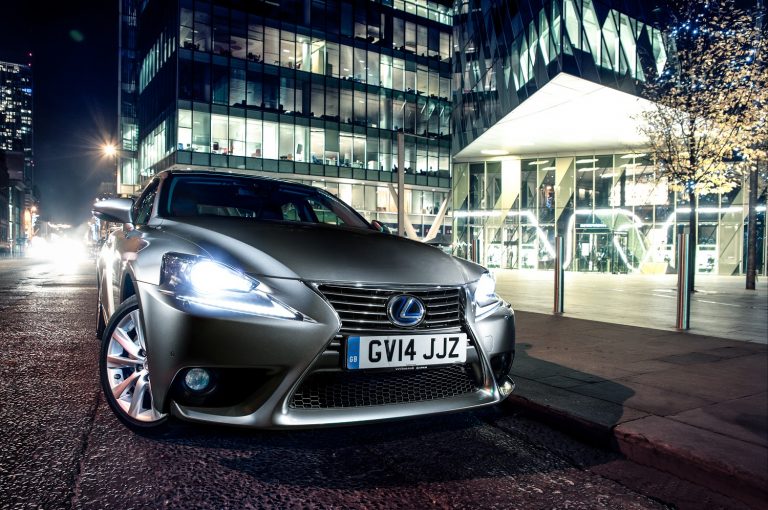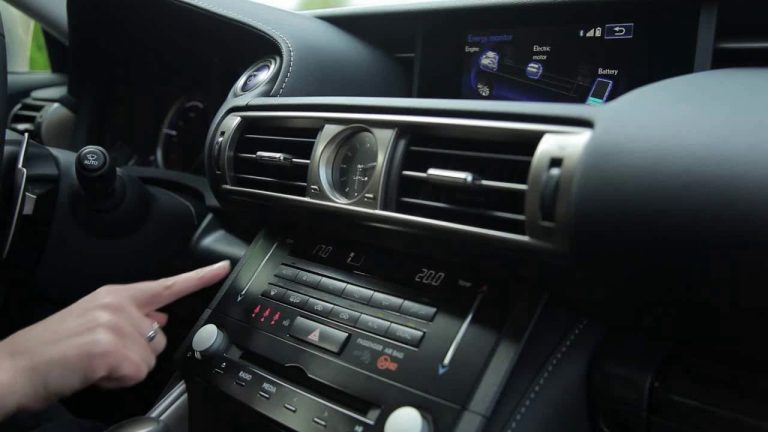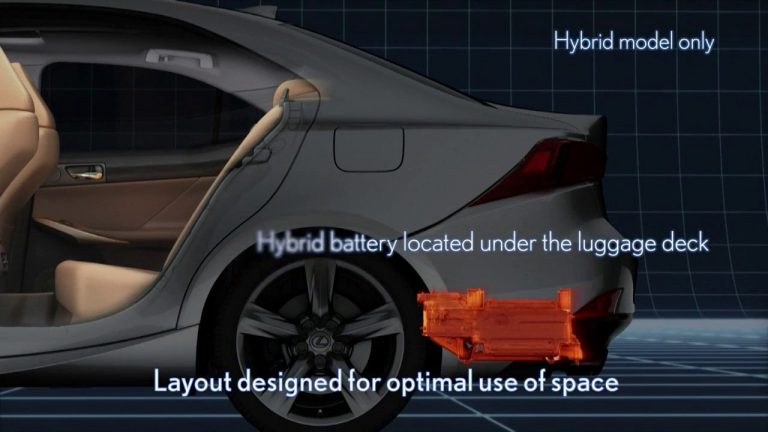European Premiere Of The All-New Lexus IS
KEY POINTS
- All new Lexus IS sports saloon range revealed at Geneva motor show
- IS 300h – the first IS with Lexus Hybrid Drive, with class-leading CO2 emissions from 99g/km and 65.7mpg combined cycle fuel consumption
- IS 250 powered by 2.5-litre V6 petrol engine,
- Both versions available with sports-focused F Sport package
- Available to order in the UK now, with deliveries from mid-July
- On-the-road prices from £26,495
The all-new Lexus IS range makes its European debut at the 2013 Geneva motor show prior to going on sale this summer. The range includes the IS 300h, the first IS model with Lexus Hybrid Drive, and the petrol-powered IS 250. The line-up will also include a further evolution of Lexus’s F Sport package, available for both models.
In the UK both versions are available to order now, with customer deliveries from mid-July.
Acknowledging that driving performance is the prime consideration for sports saloon customers, Lexus has engineered the new IS to deliver outstanding dynamic performance and driver engagement. It also adopts more powerful, distinctive styling inside and out, led by a dramatic interpretation of Lexus’s hallmark spindle-shaped front grille arrangement.
Junichi Furuyama, IS Chief Engineer, explained: “We adopted an entirely different approach to the development of the new IS. Rather than develop each individual aspect in the hope they will combine to offer an engaging driving experience, we first established the kind of driving experience owners desire. With this as our initial premise, we then developed the individual performance elements to support it.
“Every aspect of the new IS has been engineered with a focus on sporting performance, agile handling, accurate response to driver input and highly communicative feedback.”
The new IS showcases an all-new interior that combines authentic Lexus quality and refinement with a more sporting and focused environment for the driver. There is also a significant improvement in space for rear seat passengers and a larger, more user-friendly boot.
DESIGN
Exterior
The new IS’s sleek surfacing and tight, sporting proportions capture the spirit of the advances Lexus has made in the car’s dynamic capabilities and driving performance.
Measuring 4,660mm overall, the new IS is 75mm longer and 10mm wider than its predecessor. The front overhang has been increased by just 5mm, so 70mm have been added to the wheelbase, taking it to 2,800mm.
The IS followed the latest generation GS and LS is adopting the Lexus spindle front grille arrangement, giving the model a more powerful road presence and stronger brand identity.
True to Lexus design tradition, the headlamp units are set on a higher plane than the grille, while the pop-up bonnet design allows for a high degree of pedestrian impact protection, while permitting the lowest possible frontal profile.
There is also a new, powerfully articulated headlamp cluster design, with Lexus’s signature L-shaped daytime running lights presented independently below.
In profile, the new IS presents a strong, horizontal belt line that gives the impression of larger rear tyres and a lowered centre of gravity. The mass of the cabin appears to be concentrated towards the rear of the car, adding a sense of weight over the rear wheels. A rising crease line flows up from the lower body, through the rear wheel arch and into the rear lamp clusters, adding extra dynamism to the design.
The coupe-like lines are amplified by a hemming treatment to the rear wheel arches which allows the tyres to be set 5mm further outboard and closer to the wheel arches. The sleek appearance is further enhanced by a laser-brazed structure which joints the roof and side members without the need for any unsightly roof drip moulding.
Interior
The cabin design is clean and elegant, with an ergonomically ideal environment for the driver.
The new-design driver’s seat is more comfortable, with a quilted finish to the covering, and provides better lateral support. The seat hip point has been lowered by 20mm and there is a new, three-spoke, 370mm diameter steering wheel – inspired by the LFA – fitted with paddle shifts. The paddles have been redesigned for easier, more accurate operation, and the wheel-mounted switchgear benefit from revised ergonomic design.
The angle of the steering wheel has been lowered by three degrees and its reach adjustment has been increased by 23mm, to give a more sporting driving position. Thanks to the rest position of the windscreen wipers being brought down by 15mm, the driver enjoys the same angle of vision as in the current IS model.
The 70mm increase in the wheelbase has allowed 50mm to be allocated to rear seat space and 20mm to increased boot capacity. The 10mm increase in vehicle width helps increase comfort for rear seat passengers, who also benefit from an 85mm increase in knee room thanks to a thinner front seatback design. Access to the rear is easier, too, with a 20mm increase in the gap between the centre pillar and the front corner of the seat.
The new rear seats also have a 60:40 split-folding function.
High quality materials and finishes are used throughout the interior to convey a contemporary, premium look, supported by Lexus’s renowned craftsmanship and attention to detail. Many soft-touch areas have been created, including knee pads either side of the centre console.
Following the example of the new GS and LS, the IS adopts a Drive Mode Select system, with illumination of the meters and multi-information display changing from blue to red when sport driving modes are selected. On the full hybrid IS 300h, this also prompts the hybrid system indicator to switch to a tachometer.
TECHNOLOGY
Dual-zone air conditioning with electrostatic switches
The new IS has a dual-zone air conditioning system with touch-sensitive electrostatic switches to control temperature. Sliding a finger up or down the bar shaped switch adjusts the temperature in half-degree steps; alternatively you can simply press the up and down arrow markings at the top and bottom of the switch.
Advanced multi-media systems
Two multimedia systems are available, used in conjunction with the high-resolution, seven-inch colour display: Lexus Display Audio and Electro Multi Vision Navigation.
The Lexus Display Audio is controlled using an eight-direction joystick and now includes a smartphone linking function so smartphone navigation applications can be used, with information presented on the display screen.
The Electro Multi Vision Navigation is operated using a second generation version of Lexus’s Remote Touch Interface. This controller works like a computer mouse and has been revised to be even more user-friendly.
Premium sound system
The new IS comes as standard with a sound system that includes a fully digital, Class D, six or eight-channel amplifier that can create virtually distortion-free sound with minimal voltage losses. The natural sound dynamics and rich harmonies generated by its high definition amplification are faithfully reproduced in an improved six or eight-speaker layout, which includes a new 55mm wide-range tweeter.
Mark Levinson Premium Surround System
The Mark Levinson Premium Surround System, available with the new IS’s Electro Multi Vision Navigation, creates sound based on the concepts of Effortless Dynamics and Effortless Transient Response. These combine natural dynamics with high response and tracking performance to give sound quality equivalent to a live concert hall performance.
Using the same technologies found in top-end home audio systems, it features a 12-channel, fully digital Class-D amplifier that generates 125W per channel through 12 GreenEdge high-efficiency speakers plus three coaxial Unity speakers. A new auto volume system automatically adjusts the volume for each track played to ensure consistent volume levels and full audibility of even the quietest passages of music.
The power-saving GreenEdge technology in each of the speakers allows twice the volume for the same power consumption. It covers a wider frequency band than conventional systems, giving a better dynamic range. The Mark Levinson system includes three new 90mm GreenEdge Unity speakers mounted in the front of the cabin, with a coaxial structure which integrates mid and high-range units within the same structure.
To the rear there are two further 90mm GreenEdge units which feature a new Wide Dispersion technology, with built-in acoustic lenses to disperse sound more evenly through the cabin. Together these five speakers give consistent timbre for front and rear seat occupants, resulting in a new level of surround sound definition, atmosphere and aural quality.
A new 200mm GreenEdge subwoofer uses the latest inverted motor structure technology, in which the magnet driving the speaker cone is mounted inversely, significantly reducing the depth of the unit with no loss in power or acoustic performance.
POWERTRAINS
Two versions of the new IS will be available: the IS 250, with a 2.5-litre V6 petrol engine, and the full hybrid IS 300h, the first IS to use the Lexus Hybrid Drive system, incorporating a four-cylinder Atkinson cycle petrol engine.
IS 300h
The introduction of the new IS 300h reinforces Lexus’s commitment to the future of full hybrid technology. It uses a second generation Lexus Hybrid Drive that delivers significant improvements in fuel consumption and CO2, NOx and particulate emissions, with no loss of performance.
The system features a 141bhp/105kW electric motor and a newly developed 2.5-litre four-cylinder Atkinson cycle petrol engine that produces a maximum 178bhp/133kW. The engine benefits from a new D-4S fuel injection system, Dual VVT-i intelligent variable valve timing and a high-efficiency exhaust gas recirculation system.
The rear wheels are driven through the hybrid powertrain’s E-CVT transmission. Total system output is 220bhp/164kW, enabling nought to 62mph acceleration in 8.3 seconds and a 125mph top speed.
Thanks to Lexus Hybrid Drive’s improved efficiency, average fuel consumption is 65.7mpg and CO2 emissions are from a class-leading 99g/km (figures apply to the IS 300h SE model with 16-inch wheels).
The new IS 300h is the first Lexus hybrid in which the hybrid battery is located beneath the luggage deck board, which means boot space is close to that of its petrol-powered counterparts.
Sequential Shiftmatic
The IS 300h’s seamless E-CVT transmission uses shift-by-wire technology, operated using an electronic shift lever.
Selecting Sport or Sport S drive mode allows the transmission to work as a sequential shiftmatic system, operated using the paddle shifts on the steering wheel. The system has been tuned to closely match increases in engine speed with vehicle acceleration. Under deceleration, engine braking force is delivered in six steps, with a shift feel similar to that of a manual transmission. Together these enhancements to the E-CVT help create a more engaging driving experience.
Active Sound Control
The driving experience gains an extra dimension thanks to Active Sound Control, a new technology that compliments engine sound with an audio feed through a dedicated speaker that delivers the sound of acceleration and deceleration, even when the hybrid system is running purely on electric power, with the engine switched off.
IS 250
The new, rear-wheel drive IS 250 is powered by a 2.5-litre V6 petrol engine, with a maximum 204bhp/152kW at 6,400rpm and 250Nm of torque at 4,800rpm, enabling nought to 62mph acceleration in 8.1 seconds and a top speed of 140mph.
The engine, which featured in the previous IS 250, is a chain-driven DOHC 32-valve unit with a particularly compact and lightweight design. Its weight-saving features include a die-cast aluminium cylinder block and intake manifold, a resin intake chamber and installation of both the water and oil pumps within the chain cover. Performance is enhanced by the V6’s D-4 direct injection and Dual VVT-i intelligent variable valve timing.
Six-speed Super Electronically Controlled Transmission
The IS 250’s 6 Super ECT close-ratio six-speed automatic transmission has a sequential manual shift mode. It benefits from numerous technologies that enable faster shift speeds, earlier torque converter lock-up and downshift throttle blips, allied to the different driving modes available in the IS’s Drive Mode Select system.
DRIVING DYNAMICS
The development of the new IS has targeted best-in-class driving enjoyment, but not the cost of the quietness and comfort that are an essential part of any Lexus.
The new bodyshell is lighter, yet more rigid. The front suspension has been revised and an all-new rear suspension design has been introduced, to give excellent grip and response to steering inputs.
A new steering system gives lighter, smoother and more accurate feel, with an enhanced response and feedback.
The new Drive Mode Select system features (on UK versions) four switchable driving modes: EV (IS 300h only), Eco, Normal, and Sport/Sport S, which deliver the driver’s preferred balance of economy, comfort, performance and handling.
F Sport
The IS F Sport models not only display more sporting design features inside and out, they also benefit from genuine dynamic enhancements, notably specially tuned front and rear suspension systems.
The F Sport versions can be instantly recognised thanks to their special grille and front bumper design: there are more prominent chrome trim elements and a different, L-shaped mesh pattern is used for the grille. The “waistline” of the spindle-shaped grille is set higher than on the standard models, creating a larger lower grille that can draw in the greater volume of cooling air needed for sportier driving.
The front bumper features LED fog lamps at each corner and specific aerodynamic detailing to provide both downforce and extra brake cooling. The F Sport 18-inch alloy wheels have a distinctive Y-spoke design and a dark metallic finish, giving them a link to the LFA’s bloodline.
Inside, the F Sport inherits the innovative driver’s meter design from the LFA, with its moving central ring. Special trim details include an F Sport steering wheel and shift knob finished in perforated leather, a metallic 3D-effect detailing, black seat stitching and aluminium pedals and scuff plates. Two interior colour schemes will be available, including a new Dark Rose exclusive to F Sport.
The IS F Sport also has an exclusive seat design that provides extra support. The seats are made using an integrated foaming method that ensures there are no gaps between the upholstery and the filling, giving both excellent comfort and great lateral holding.
The front and rear suspension and the electric power steering are tuned to enhance the F Sport models’ handling, without compromising ride quality.
ADVANCED SAFETY
The new IS builds on the superior safety performance of its predecessor with high levels of active, passive and preventive safety, including a number of new active safety features.
According to market, the new IS will offer feature a number of advanced, new active safety features, including automatic headlamp high beam operation, Lane Departure Alert, Blind Spot Monitor and Rear Cross Traffic Alert.
The new IS benefits from a highly rigid body structure for excellent car-to-car impact performance. In the cabin there are 10 airbags as standard, and, in the pursuit of greater protection for pedestrians, the bonnet has a new pop-up design to help prevent serious injury in a collision.
UK model range and prices
| MODEL |
ENGINE |
TRANSMISSION |
OTR PRICE |
| IS 250 SE |
2.5 V6 petrol |
6AT |
£26,495 |
| IS 300h SE |
2.5 Lexus Hybrid Drive |
E-CVT |
£29,495 |
| IS 250 Luxury |
2.5 V6 petrol |
6AT |
£27,995 |
| IS 300h Luxury |
2.5 Lexus Hybrid Drive |
E-CVT |
£30,995 |
| IS 250 F Sport |
2.5 V6 petrol |
6AT |
£30,495 |
| IS 300h F Sport |
2.5 Lexus Hybrid Drive |
E-CVT |
£33,495 |
| IS 250 Premier |
2.5 V6 petrol |
6AT |
£35,495 |
| IS 300h Premier |
2.5 Lexus Hybrid Drive |
E-CVT |
£38,495 |
TECHNICAL SPECIFICATIONS
(subject to final EU homologation)
| ENGINE |
IS 300h |
IS 250 |
| Engine code |
2AR-FSE |
4GR-FSE |
| Cylinders and configuration |
4 in-line |
V6 |
| Valve mechanism |
16-valve DOHC with Dual VVT-i |
24-valve DOHC with Dual VVT-i |
| Bore x stroke (mm) |
90.0 x 98.0 |
83.0 x 77.0 |
| Displacement (cc) |
2,494 |
2,499 |
| Compression ratio |
13.0:1 |
12.0:1 |
| Fuel injection |
EFI, D-4S |
EFI, D-4 |
| Max. power (bhp/kW @ rpm) |
178/133 @ 6,000 |
204/152 @ 6,400 |
| Max. torque (Nm @ rpm) |
221 @ 4,200 – 5,400 |
250 @ 4,800 |
| HYBRID SYSTEM |
IS 300h |
|
| Motor generator | ||
| Motor type |
Permanent synchronous magnet |
|
| Max. voltage (V) |
650 |
|
| Max. power (bhp/kW) |
141/105 |
|
| Max. torque (Nm) |
300 |
|
| Hybrid battery | ||
| Type |
Nickel-metal hydride (NiMH) |
|
| Nominal voltage (V) |
230.4 |
|
| Number of cells |
192 |
|
| System voltage (V) |
650 |
|
| Total system output (bhp/kW) |
220/164 |
|
| PERFORMANCE |
IS 300h |
IS 250 |
| Max. speed (mph) |
124* |
140* |
| Acceleration 0-62mph (sec) |
8.3* |
8.1* |
| FUEL CONSUMPTION AND EMISSIONS |
IS 300h |
IS 250 |
| Combined (mpg) |
65.7 |
32.8 |
| CO2 (g/km) |
from 99 (SE model) |
199 |
| Fuel tank capacity (l) |
66 |
66 |
| TRANSMISSION |
IS 300h |
IS 250 |
| Type |
E-CVT |
Automatic |
| BRAKES |
IS 300h |
IS 250 |
| Front |
Ventilated discs |
Ventilated discs |
| Rear |
Ventilated discs |
Solid discs |
| STEERING |
IS 300h |
IS 250 |
| Turns lock-to-lock |
2.84 |
2.84 |
| Turning radius – tyre (m) |
5.2 |
5.2 |
| Turning radius – body (m) |
5.5 |
5.5 |
| DIMENSIONS – EXTERIOR |
IS 300h |
IS 250 |
| Overall length (mm) |
4,665 |
4,665 |
| Overall width (mirrors folded) mm |
1,810 |
1,810 |
| Overall width (mirrors included) mm |
2,027 |
2,027 |
| Wheelbase (mm) |
2,800 |
2,800 |
| Front track (mm) |
1,535 |
1,535 |
| Rear track (mm) |
1,550 1,540 (18in wheel) |
1,550 1,540 (18in wheel) |
| Front overhang (mm) |
830 |
830 |
| Rear overhang (mm) |
1,035 |
1,035 |
| Coefficient of drag (Cd) |
0.28 |
0.28 |
| DIMENSIONS – INTERIOR |
IS 300h |
IS 250 |
| Length (mm) |
1,945 |
1,945 |
| Width (mm) |
1,500 |
1,500 |
| Height (mm) |
1,115 |
1,115 |
| Couple distance |
913 |
913 |
| Boot capacity (l) |
450* |
480* |
| WEIGHTS |
IS 300h |
IS 250 |
| Kerb weight min. – max. (kg) |
1,620 – 1,680 |
1,555 – 1,645 |
| Gross vehicle weight (kg) |
2,130 |
2,090 |
| Towing capacity – braked (kg) |
750 |
1,500 |
| Towing capacity – unbraked (kg) |
750 |
750 |
* Lexus in-house figures



